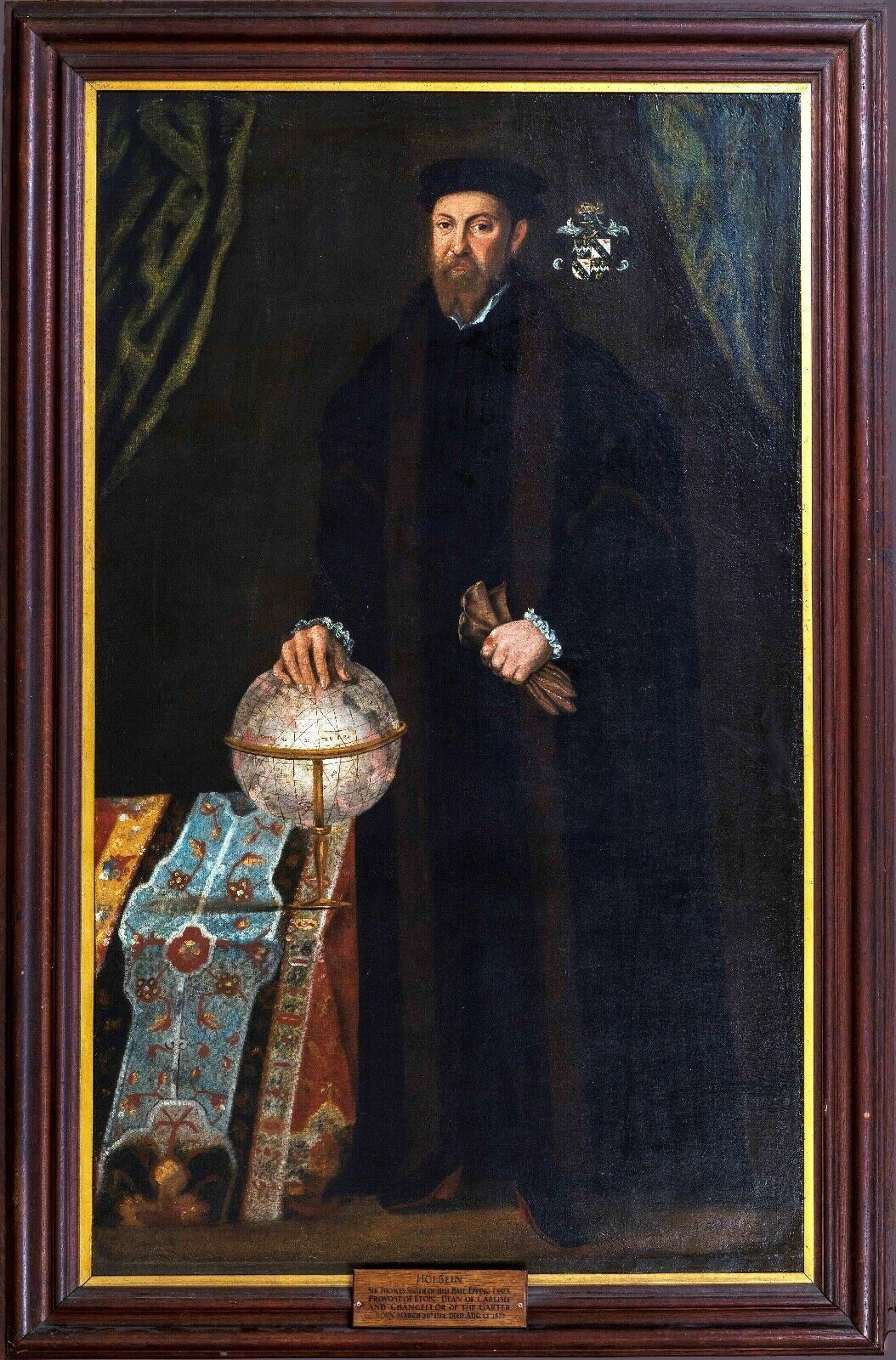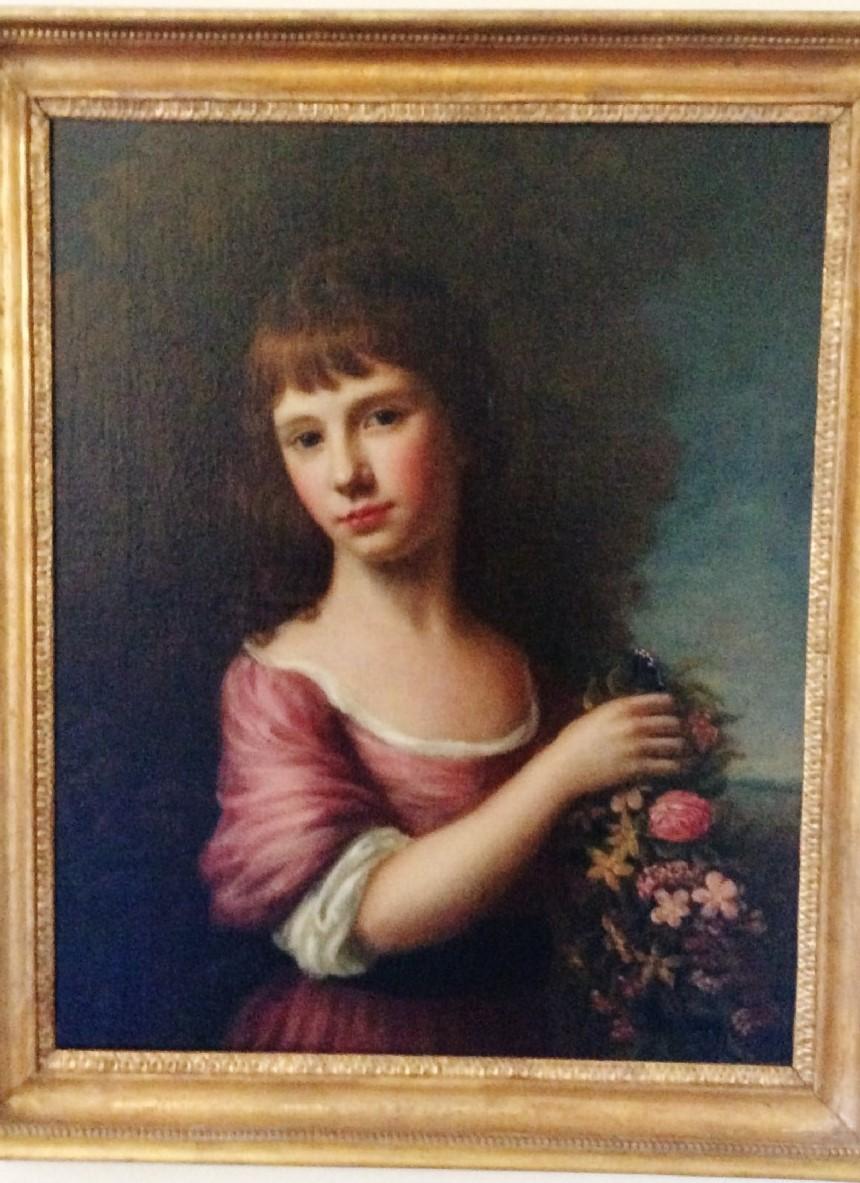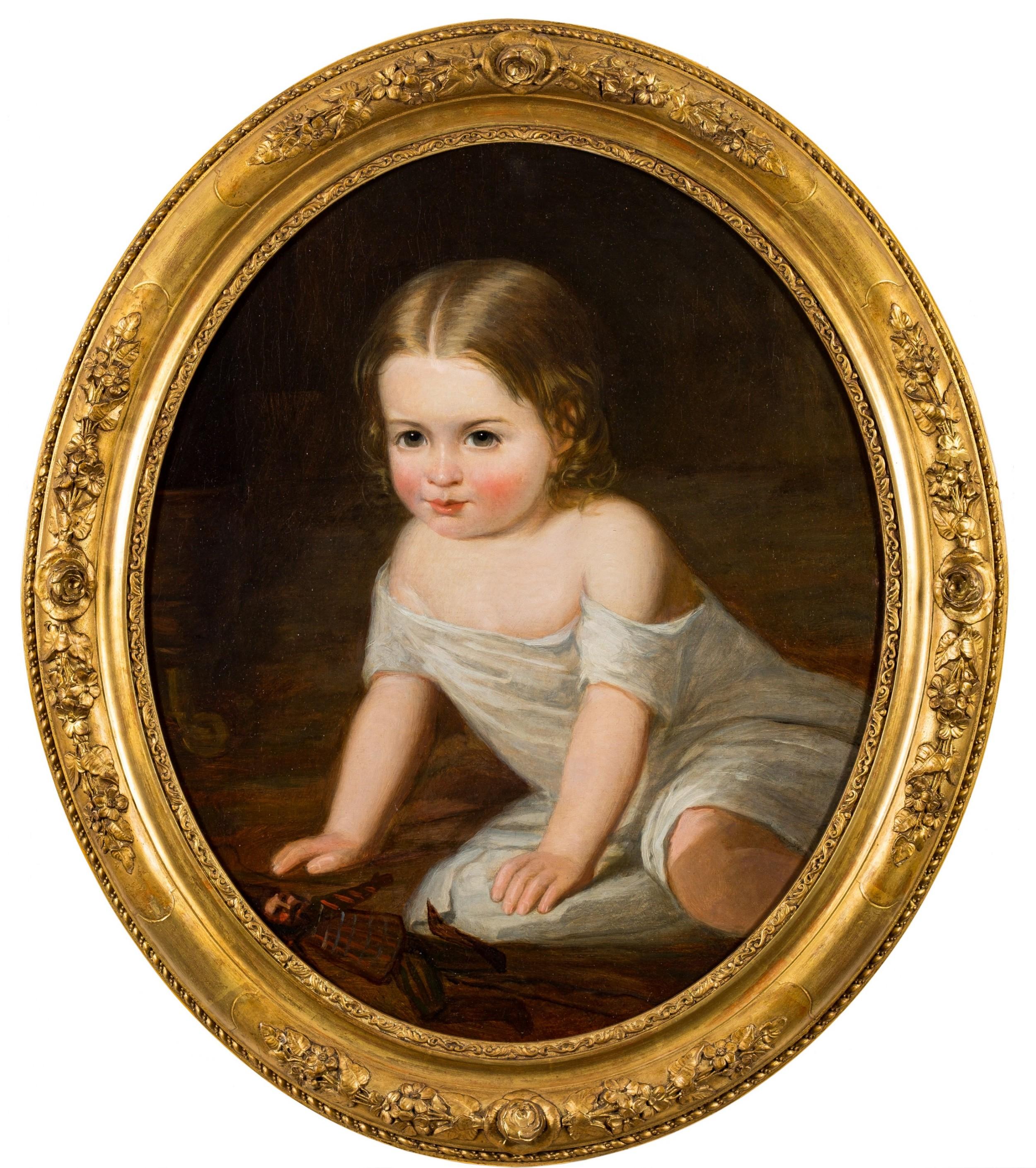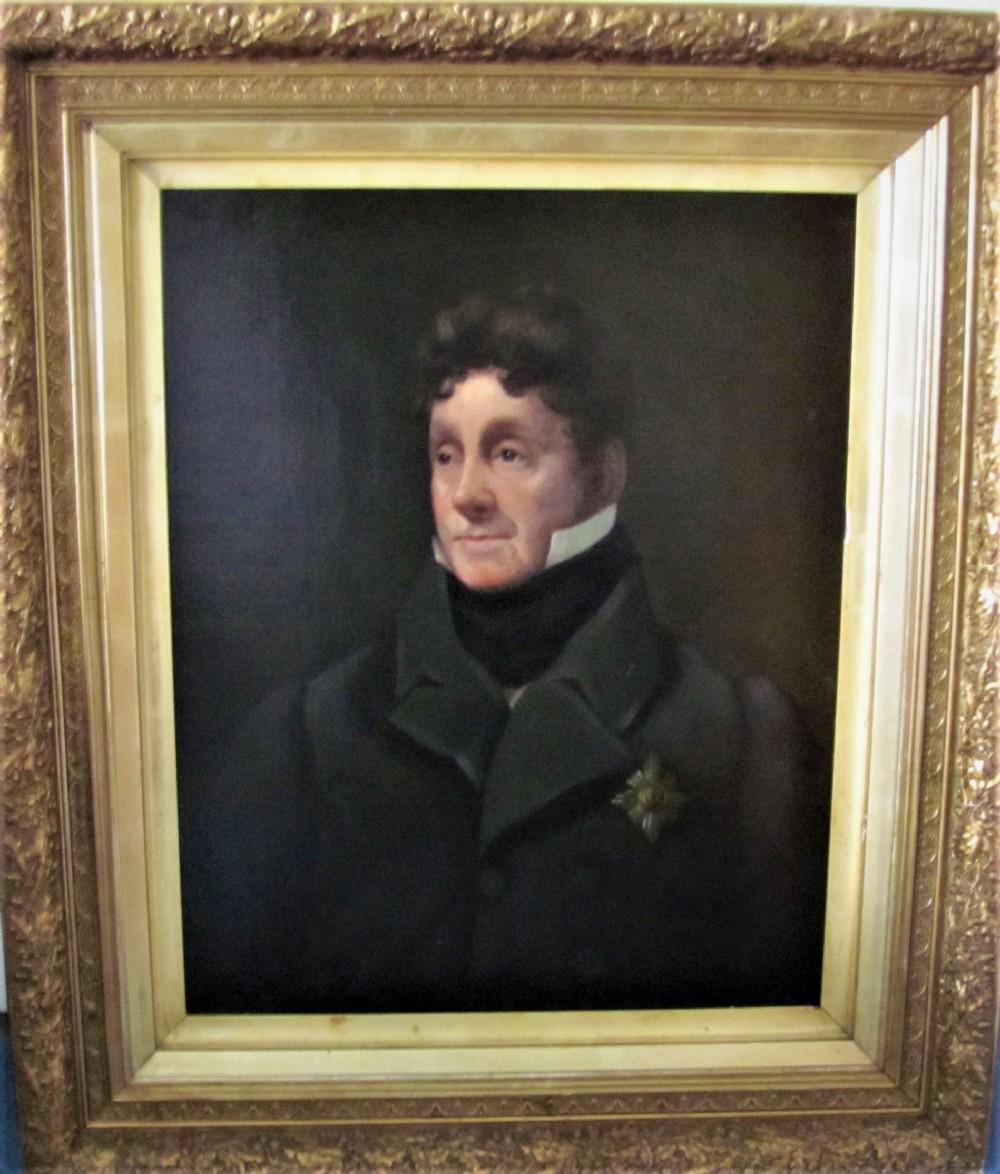Items Similar to Holy Family Giovannino Bronzino Paint Oil on table 16th Century Old master Italy
Want more images or videos?
Request additional images or videos from the seller
1 of 23
Holy Family Giovannino Bronzino Paint Oil on table 16th Century Old master Italy1530-1560
1530-1560
About the Item
Agnolo di Cosimo, known as 'il Bronzino' (Monticelli of Florence, 1503 – Florence, 1572)
The Holy Family with San Giovannino
Oil on table (120 x 90cm. - In antique frame 146 x 116 cm.)
The work comes accompanied by the expertise of Professor Stephan D. Pepper, dated 5.12.96 (Rome)
A painting of great charm and collectible relevance is examined, a high quality version of the famous 'Holy family with San Giovannino' created in 1528 by Andrea del Sarto (Florence 1486 - 1530), one of the most outstanding exponents among the protagonists of the full Florentine Renaissance.
Better known as the "Holy Family Borgherini" from the name of the client Giovanni Borgherini, a member of one of the most important Florentine families of the time, it is now kept in the Metropolitan Museum of New York (Inv. 22.75).
With this grandly solemn composition, Sarto confirmed that he was «the flawless painter», as Giorgio Vasari liked to call him: his figures are masterfully drawn, rendered with splendid chromatic harmony, and finally the relationship between the figures, arranged with an air of nobility , gives us a sublime choreography that connects the four characters.
The painting, commissioned in the same year in which Florence managed to free itself from the dominion of the Medici and declared itself a Republic, also contains a political meaning, with John the Baptist, the city's patron saint, who offers the terrestrial globe with the cross to the little Jesus Child, continuing but to shake it with his hands, to symbolize that both - therefore both the city and the Church - will act as protectors and guarantors of the freedom of the Florentine republic.
Considered one of the most important jewels of the Florentine Renaissance, a masterpiece of the painter's early maturity, it was one of the artist's most admired and copied compositions, enjoying particular fortune with Florentine collectors already at the time: this explains the numerous copies, autograph or workshops, which enrich as many international museums [1].
Although there is not, in terms of composition, a perfect correspondence between the original and the painting that we propose - which in fact slavishly reproduces the compositional structure - there are also differences in the pictorial layout and in the consequent appearance.
The very high pictorial quality that distinguishes this work allows us to associate its authorship with a leading author of Florentine origin of the early sixteenth century, who was able to restore all the original poetry, albeit personalizing it with his own stylistic imprint.
In particular, the pictorial material applied in a uniform way and the superb use of the nuanced, with a modeling that leads us - as suggested by Stephan D. Pepper in his report - to rediscover the youthful hand of Agnolo di Cosimo, know as 'il Bronzino (Monticelli di Florence, 1503 - Florence, 1572), undisputed master for the accuracy in the drafting of the pictorial material and the 'veiling' treatment, with which he made his painting glazed and transparent.
From the first works, Bronzino developed an unmistakable style, unique for its elegance, compositional balance, and chromatic splendor, with a unique pictorial power made possible by a modeling with decisive lines, which gives the figures a sculptural and smooth appearance similar to porcelain .
Elements such as the spots of light that illuminate the subjects, or the semi-transparent veil of the Madonna have been rendered here in a virtuosic way.
ADDITIONAL INFORMATION:
The work is sold with a certificate of authenticity and a descriptive iconographic sheet.
We take care of and organize the transport of the purchased works, both for Italy and abroad, through professional and insured carriers.
It is our duty to inform you that, given the delicacy of some particular antique frames, there is the possibility that small damage to the gilding may occur during transport, despite the packaging being carried out with the utmost care.
It is also possible to see the painting in the Riva del Garda gallery, we will be happy to welcome you to show you our collection of works.
Contact us, without obligation, for any additional information.
- Creation Year:1530-1560
- Dimensions:Height: 57.49 in (146 cm)Width: 45.67 in (116 cm)
- Medium:
- Movement & Style:
- Circle Of:Agnolo Bronzino (1503 - 1572, Italian)
- Period:
- Condition:
- Gallery Location:Riva del Garda, IT
- Reference Number:1stDibs: LU988111232312
About the Seller
4.8
Platinum Seller
These expertly vetted sellers are 1stDibs' most experienced sellers and are rated highest by our customers.
Established in 2017
1stDibs seller since 2018
206 sales on 1stDibs
Typical response time: <1 hour
- ShippingRetrieving quote...Ships From: Riva del Garda, Italy
- Return PolicyA return for this item may be initiated within 7 days of delivery.
More From This SellerView All
- Terwesten Woman Allegory Art Paint Oil on canvas 17/18th Century Old masterLocated in Riva del Garda, ITMattheus Terwesten (The Hague, 1670 - 1757) Portrait of a young woman with palette and brushes, as Allegory of the art of Painting Oil on canvas 160 x 91 cm. - In frame 178 x 107 cm...Category
17th Century Old Masters Paintings
MaterialsOil
- Perroneau Portrait Lady Woman Paint Oil on canvas 18th Century Old master FrenchLocated in Riva del Garda, ITJean-Baptiste Perroneau (Paris, 1715 – Amsterdam, 1783) Portrait of a lady Oil on oval canvas 60 x 50 cm. - In frame 77 x 66 cm. Work accompanied by expertise: Raffaelle Colace (Cremona), Ferdinando Arisi Reference bibliography: d’Arnoult, Dominique (2014) Jean-Baptiste Perronneau, c 1715-1783, un portraitiste dans l’Europe des Lumières Excerpt from the expertise of Dr. Colace: This refined portrait of a lady is a perfect example of the style of Jean-Baptiste Perroneau, a very talented French painter, whose most beautiful works are located, just like this one, between the fifth and sixth decades of the eighteenth century. "Perroneaeu is more naturally colored than La Tour, the est, in the peinture de poussière colorée, tout plein de tons clairs, frais, presque humides": this is how his brothers wrote about him in La Maison d...Category
18th Century Old Masters Paintings
MaterialsOil
- Portrait Knight Paint Oil on canvas 17th Century Lombard school Old master ItalyLocated in Riva del Garda, ITLombard painter of the 17th century Portrait of a Knight in Armour Oil on canvas 81 x 70 cm./ Framed 93 x 82 A handsome gentleman in armour, immortalised in an authoritative and pr...Category
17th Century Old Masters Paintings
MaterialsOil
- Ecce Homo Coxie Paint 16/17th Century Paint Oil on table Old master Flemish ArtLocated in Riva del Garda, ITCircle of Michael Coxie (Malines, 1499 - Malines, 1592) Ecce Homo with Pontius Pilate Oil on panel Flemish school 16th-17th century 112 x 81 cm - framed 121 x 90 cm. The proposed p...Category
16th Century Old Masters Paintings
MaterialsOil
- Portrait Woman Princess Diziani Paint 18th Century Oil on canvas Old master ArtLocated in Riva del Garda, ITGaspare Diziani (Belluno 1689 - Venice 1767) Portrait of a Young Princess (Salome?) Oil on canvas 42 x 33 cm Framed 70 x 63 cm A charming portrait of a beautiful young woman with ...Category
18th Century Old Masters Paintings
MaterialsOil
- Cupid Portrait Parmigianino Paint 17/18th Century Oil on canvas Old master ItalyLocated in Riva del Garda, ITFollower of FRANCESCO MAZZOLA, known as IL PARMIGIANINO (Parma, 1503 - Casalmaggiore, 1540) Cupid Carving His Bow (as the triumph of love and desire over reason and knowledge) Oil o...Category
18th Century Old Masters Paintings
MaterialsOil
You May Also Like
- Portrait Of Thomas Smythe (1514-1577) School of Hans HOLBEIN (1497-1543)By Hans HolbeinLocated in Blackwater, GBPortrait Of Thomas Smythe (1514-1577), 16th Century School of Hans HOLBEIN (1497-1543) Fine huge 16th Century English Old Master portrait of Sir Thomas...Category
16th Century Old Masters Portrait Paintings
MaterialsOil
- William Wissing (follower) 19th Century Portrait Queen Mary IILocated in York, GBA 19th century oil on canvas, portrait of a young woman.This portrait is believed to be of Queen Mary II taken from an engraving of the painting, Halswell Park Sale, 1948, lot no.1323, Housed in a decorative gilt frame.Size overall being 70 x 86 cm high (27.5 x 33¾ inches approx) size of painting 54 x 68 cm (21 x 26 inches approx) To the rear of the portrait is a newspaper cutting of the engraving ,also a typed note regarding the provenance of the painting (see photo) Condition overall is very good, the Canvas has been relined, under UV there are areas of overpaint to bosom.Frame overall very good some minor self coloured losses Mary II (30 April 1662 – 28 December 1694) Mary, born at St James's Palace in London on 30 April 1662,eldest daughter of James, Duke of York (the future James II & VII) , and his first wife, Anne Hyde. Mary's uncle was King Charles II, her maternal grandfather, Edward Hyde, 1st Earl of Clarendon, served for a lengthy period as Charles's chief adviser. Mary married William of Orange. Willem Wissing, known in England as William Wissing...Category
19th Century Old Masters Portrait Paintings
MaterialsOil
- Nathaniel Hone, portrait of "flora" roman goddess, 18th centuryBy Nathaniel Hone the ElderLocated in York, GBI have great pleasure in offering for sale this beautiful portrait, by Nathaniel Hone, the elder. 18th century. The painting is of Ann Anderson, wife...Category
18th Century Old Masters Portrait Paintings
MaterialsOil
- 19th Century Portrait, Child At Play , Attributed To Henry Tanworth WellsLocated in York, GB19th century portrait, child at play ,Attributed to Henry Tanworth Wells A beautiful oval portrait of a young child at play, attributed to the portrait painter Henry Tanworth Wells. finely executed, this oil on canvas is in excellent condition. Housed in a period frame. The size overall is 79 cm x 62 cm whilst the painting is 56 cm x 46 cm Henry Tanworth Wells [1828-1903] Henry Tanworth Wells RA was an English miniature and portrait painter. He was a member of the Pre-Raphaelite circle though he painted in the academic style. His most popular painting...Category
19th Century Old Masters Portrait Paintings
MaterialsOil
- Henry Raeburn, (circle) 19th Century portrait of Sir Charles Forbes EdinglassieBy Henry Raeburn (circle)Located in York, GBPortrait of Sir Charles Forbes of Edinglassie, Oil on canvas. The size of the portrait is 75 cm x 59.5 cm whilst overall the size is 106 cm x 91 cm In very good condition.There has been some restoration/overpainting etc.There is some minor craquelure. Housed in a period gilt frame decorated with acorns and leaves Overall a good portrait, circle of a fine scottish artist , with an interesting sitter, his details below. sir Charles Forbes of Edinglassie Sir Charles Forbes, 1st Baronet (1774–1849) was a Scottish politician, of Newe and Edinglassie, Aberdeenshire. Forbes was the son of the Rev. George Forbes of Lochell. He was a descendant of Alexander Forbes of Kinaldie and Pitsligo, and was in 1833 served heir male in general to Alexander Forbes, 3rd lord Forbes of Pitsligo, father of Alexander Forbes, 4th Lord Forbes of Pitsligo, attainted in 1745. Forbes was of a bluff but kindly nature, diffident as to his own merits, of a straightforward and manly character. On the death of his uncle in 1821 Forbes succeeded to the entailed estates of the Forbeses of Newe, and was created a baronet by patent in 1823.[1] He married in 1811. His daughter, Elizabeth, married General, Lord James Hay, second son of the seventh Marquess of Tweeddale. Sir Henry Raeburn FRSE, RA, RSA (1756-1823) Scottish portrait painter and Scotland's first significant portrait painter since the Union to remain based in Scotland. He served as Portrait Painter to King George IV in Scotland Raeburn had all the essential qualities of a popular and successful portrait painter. He was able to produce a telling and forcible likeness; his work is distinguished by powerful characterisation, stark realism, dramatic and unusual lighting...Category
19th Century Old Masters Portrait Paintings
MaterialsOil
- English Portraits of Lady, Dorothy & Jane Wood c.1750, Remarkable Carved FramesBy John Theodore HeinsLocated in London, GBPortraits of a Lady, Dorothy and Jane Wood c.1750, Fine Carved Frames By John Theodore Heins (1697-1756) Titan Fine Art present these works, which formed part of a collection of family heirlooms of the Wood family who were from Bracon Ash, Norfolk, since the medieval period. Jane’s daughter Ann, was famously married on board the Foudroyant, off Naples, in a lavish ceremony in 1799, with Lord Nelson himself giving away the bride. The paintings descended within the family for around 275 years until recent and are exquisite examples of Georgian portraiture in England and are some of the best works by the artist. The original hand carved and gilded pierced frames are magnificent works of art in their own right. The sitters were two children, out of several, of Thomas Wood (1682-176) and Dorothy Huby (1700-1759). The family is from Norwich, which in 1720 was a city second in importance only to London. Their aunt, Jane Wood (1677-1756), was a Franciscan nun in Bruges. Dorothy Wood (in the blue dress) was baptised 2nd June 1726 and she died unmarried around 1759. Jane (in the pink dress) gave birth to at least six children during her thirty two-year marriage. She was baptised 14 Oct 1727 at Bracon Ash. Jane married Knipe Gobbet (1730/5-1791) who was Sheriff in 1768 (and Mayor in 1771) of the City of Norwich, and later Lieutenant-Colonel of the West Norfolk Regiment, in which corps he had served in for many years. According to Payne’s Universal Chronicle or Weekly Gazette the marriage took place on 7th July 1758. Knipe was born at his family seat, Tacolneston Hall, to parents George Gobbet, who was Sheriff in 1710, and Ann. The couple bought and lived in a house in Norwich (later known as Gurney’s Bank House) until 1778 before moving to another one at 10 St Stephen’s Street, Norwich. Later, they inherited the family seat of Tacolnestan Hall and lived there for the remainder of their lives. Knipe Gobbet was a prominent individual and in 1779 he gave the corporation of Norwich 100 pounds, to be disposed of as they might think proper, and soon after that he was presented with a handsome field tent, marquee, and camp equipage, in testimony of their esteem for his dedication to the defence and service of this country at a time when threatened by an invasion. Although Jane was baptised a Roman Catholic Knipe was a prominent local wine merchant, JP, Alderman, sheriff, mayor and Lieutenant. Roman Catholics may have paid lip service to religious conformity as they were excluded from certain areas of public life before the Catholic Emancipation Act of 1829. Such discrimination probably lies behind the why their children are included in the registers of both the Anglican church in Tacolneston and the Norwich Catholic church in the 1760s. Jane and Knipe had one son, Thomas, who died at the age of four of a small-pox inoculation in 1762 (memorial stones in the Church of All Saints, Tacolneston) and many daughters who were schooled at the Order of the Immaculate Conception of Our Lady, in Paris. Their oldest daughter, Anne (1760-1817) was born at Tacolneston Hall. She came to the convent 30 Sept 1774 and ten days later she went to Dames St Sacrament, Rue St Louis in Paris. Their second daughter, Dorothy (died suddenly of apoplexy 21st Nov 1813), came to the convent 19th July 1777 when she was 16 years old and returned to England 23 March 1779. Frances (baptised 22 Feb 1763) came to the convent 16th April 1772 when she was 9 years old and returned 29th May 1777 – however she returned again to the convent 16th May 1778 and left 15th Oct 1778 to return home again. She later married and her surname became Negri. Another daughter, Jane, is thought to have married Juan Manuel Martinez in 1784. There was also another daughter, Mary. The eldest daughter, Ann, first married Peter Bottalini of London 27 Oct 1783 at Tacolneston Hall. They had one son together. She then married on 9th July 1799, Dr William Compton (1733- Clifton 1824), the Chancellor of Ely and the next collateral male relation to the Earl of Northampton (he had earlier marriages to Caroline and Catherine). William Compton later retired from the Commons and spent many years on the continent acting as Chancellor of Ely by proxy from 1777 for the remainder of his life. The couple were British residents of Posilipo Naples and the marriage was hosted on board the Foudroyant, off Naples, where the bride was given away by the Right Hon. Lord Nelson himself. The marriage document, signed by Lord Nelson, Lady Emma Hamilton, Captain Thomas Hardy, and others descended within the family, until sold in a sale that raised worldwide interest in 2023, for £20,160. The document is accompanied by a contemporary manuscript account of the wedding, headed 'Paragraph for the papers, sent to Messrs Coutts & Co with request to have it inserted'. Lord Nelson was a household name in Britain due to his many victories, including the Battle of the Nile against the French Navy in August 1798 – which came before the Battle of Trafalgar in 1805. The document states: 'This is to certify that, on board the Foudroyant lying in Naples Bay, on the ninth of July 1799 the marriage between William Compton & Mrs Anne Bottalin, widow, was solemnized by me S. G. Comyn HM. Chaplain to the Right Honble Lord Nelson, H.M.S. Foudroyant, in the presence of'. With the following autograph signatures: Sir William Hamilton (1731-1803), Lady Emma Hamilton (1765-1815), Horatio Nelson, Viscount Nelson (1758-1805); Sir John Thomas Duckworth (1747-1817), Sir Thomas Masterman Hardy (1769-1839), John Rushout, 2nd Baron Northwick (1769-1859), Josiah Nisbet (1780-1830), John Tyson, William Compton and Anne Bottalin, and 2 others” The document sheds light on Nelson's lesser-known side of his character. William Compton ... received "a great many favours and kindnesses" from Nelson, and most especially "the kind interest" taken in sealing his union with a wife who made him "the happiest of mortals". Anne, the aforesaid spouse, said that the admiral's "good heart" had made her "as happy as I can possibly be on this earth" ... Midshipman Parsons remembered those days nostalgically, noting Emma's "graceful form" bending over her harp to bestow "heavenly music" upon the diners on the quarterdeck and the large-decked galley, flush with opera singers, that glided alongside to serenade the sunset of each day'. Tacolneston has an ancient history of which according to the Domesday Book, Edward I granted a weekly market to be held on a Wednesday at the manor of Tacolneston and two annual fairs. The church was rebuilt in 1503 and is dedicated to All Saints. The earliest view of Tacolneston is a print of 1781 when it belonged to Knipe Gobbet Esq. John Theodore Heins (1697-1756) was a painter whose work, at his best, shows detail of an exceptionally high quality. His portraits of Anna Maria Kett nee Phillips and her husband Henry Kett, painted in 1741, are exceptional and evidence that he had the ability to portray a likeness on par with some of the best portraitists in England at the time. Heins appears to have originated in Germany but moved to the UK and settled in Norwich around 1720. From 1720 to his death in 1756, Heins built up a fine reputation as a portrait painter and painted many members of prominent Norfolk families right up to his last year. He was commissioned in 1732 to paint a portrait of the Mayor of Norwich, Francis Arnam and also the previous year's Mayor Robert Marsh...Category
18th Century Old Masters Portrait Paintings
MaterialsCanvas, Oil
Recently Viewed
View AllMore Ways To Browse
Old Family
Same Old
All Master Paintings
Old Italian Artist
Great Masters Painting
Old Masters Italy
Master Copy
Old New York City Painting
Small Old Paintings
Antique Old Painting
Grand Masters
Old Master Painting Italian
Holy Art
Italian Old Masters Art Framed
Italian Old Masters Framed Art
Painting Antique Table
Small Paintings Of Florence Italy
Old Master Style Oil Painting





